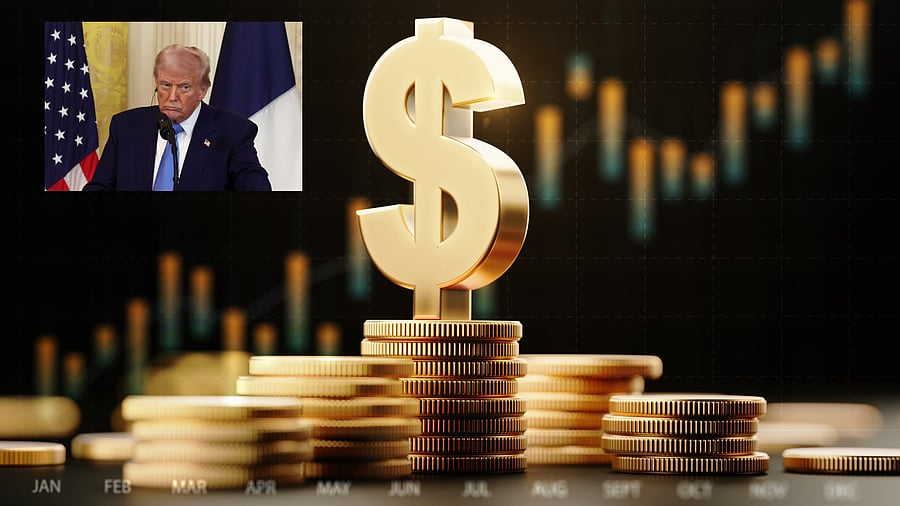
Representative image of the US dollar. (Inset: US President Donald Trump).
Credit: iStock; Reuters Photos
United States President Donald Trump is wielding the tariff bludgeon indiscriminately and heavily with the objectives of ‘Making America Great Again’ in manufacturing and maintaining the US dollar leadership as the currency in which the world trades and transact.
Additionally, Trump and Elon Musk have combined to rewire the world economic order by disrupting US participation in international development programmes, economic and environmental agreements and institutions. The withdrawal from the Paris agreement, the reduction in contribution to the WHO, and the abrupt closure of USAID programmes are just the beginning.
Will all this make the US a great manufacturing nation again and protect dollar? Or, will a new world economic order emerge with the US dollar losing its hegemony in the process?
US trade deficits dollarise the world
That US runs large trade deficits is no secret. Its contribution in dollarising the world is less understood. Over the last decade (2015-2024), the US trade deficits aggregated to $6.77 trillion.
The world denominates its exports in US dollars and accepts the US dollars in payment even when the US is not a trading partner. The US dollar is the 20th century gold to finally clear global trade transactions.
The world retains a portion of the US dollars with itself to transact and invests the rest in US treasury bonds, stocks, and other financial assets. US companies/investors use a part of these invested dollars to finance foreign direct investments, portfolio investments, and to provide loans.
All this makes the dollar the global reserve currency. Great US trade deficits are at the core of global dollar dominance.
Tariffs do not produce goods
The American consumption story has been built on import of better and cheaper goods from China and the rest of the world. America does not have a competitive manufacturing ecosystem for mass produced and consumed commodities.
Putting higher general tariffs in such a situation will only make import costlier for US consumers even if exporters absorb some tariff cost. Tariffs imposed selectively e.g. only for China or reciprocal tariffs on India can at best lead to substitution of the source of imports.
This time around Trump is wielding the tariff bludgeon to serve non-trade objectives as well. Mexico, Canada, and China have been threatened with higher tariffs to force them to halt illegal migration and to stop flowing of fentanyl in the US!
While there will be disruptions and some re-alignment of profit margins, there is no possibility, in the circumstances, of Americans or global investors rushing to establishing manufacturing capacities or the US trade deficits to shrink.
Advantage China
China has an opposite situation.
China runs enormous trade surpluses nearing $1 trillion in 2024. Its currency, Yuan, however, is hardly a global currency. Very little of global trade is denominated or transacted in Yuan. China ends up holding most of its trade surpluses in US treasuries and financial assets.
Trump has threatened 100% tariffs if BRICS play games with US dollars and trade in an alternative currency. BRICS is predominantly China now. Trump’s threat is, therefore, essentially directed at China.
Trump has subjected China with 10% higher tariffs already. Higher tariffs on Canada, Mexico, etc. have been deferred. China has not taken any counter measures so far. China, a long-term strategic thinker, is mulling over. It can convert Trump’s tariff tantrums into a once-in-a-century kind of opportunity.
If China opens for additional imports of $500 billion to $1 trillion, denominated and traded in Yuan (by shrinking its manufacturing base a little, if needed), the world would be happy to divert their manufactures to China allowing Yuan to become a major operating global currency in the bargain.
China can also decide to become the financier of the world by investing its accumulated surpluses all over the world, grounded in the Belt and Road Initiative (BRI), at more liberal terms, provide funding to the UN and other global institutions to compensate for the loss of US funds, and permitting the world to raise bond finance in Yuan.
This pivot can convert Trump’s tariff disruption into an epochal leadership advantage to China.
America isolates again
In the 19th century, the United Kingdom was global economic leader and the US an inward looking and isolated giant. The pound sterling was the ruling global currency.
Global economic, financial, and currency leadership began shifting to the US in the 1940s establishing the US dollar as the global currency. The US led the new world economic order using global developmental and financial institutions to successfully vanquish the Russian model of planned economy.
In 2024, with about $30 trillion of GDP and average per capita income of $86,600, the US is indeed the most prosperous, and the greatest nation.
In the last 40 years, China has caught up, transforming itself from a pathetically poor country into a powerful $18 trillion economy. With more than $3 trillion of reserves, China is raring to challenge US’ economic supremacy.
If China plays its cards well, there is a good chance that it can become the economic, financial, and currency leader of the world in another 10-25 years.
It will be ironical if Trump ends up ‘Throwing Back America to 19th Century Again’ with China replacing it for the global leadership.
(Subhash Chandra Garg is former Finance & Economic Affairs Secretary, and author of ‘The Ten Trillion Dream Dented’, Commentary on Budget 2024-25 and ‘We Also Make Policy’.)
Disclaimer: The views expressed above are the author's own. They do not necessarily reflect the views of DH.